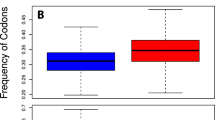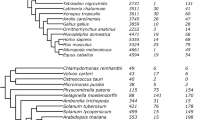Summary
This paper is concerned with the divergence of synonymous codon usage and its bias in three homologous genes within vertebrate species. Genetic distances among species are described in terms of synonymous codon usage divergence and the correlation is found between the genetic distances and taxonomic distances among species under study. A codon usage clock is reported in alphaglobin and beta-globin. A method is developed to define the synonymous codon preference bias and it is observed that the bias changes considerably among species.
Similar content being viewed by others
References
Bernardi G, Bernardi G (1985) Codon usage and genome composition. J Mol Evol 22:363–365
Bernardi G, Bernardi G (1986) Compositional constraints and genome. J Mol Evol 24:1–11
Bernardi G, Olofsson B, Filipski J, Zerial M, Salinas J, Cuny G, Meunier-Rotival M, Rodier F (1985) The mosaic genome of warm-blooded vertebrates. Science 228:953–958
Bernardi G, Mouchiroud D, Gautier C, Bernardi G (1988) Compositional patterns in vertebrate genomes: conservation and change in evolution. J Mol Evol 28:7–18
Bilofsky HS, Burks C, Fickett JW, Goad WB, Lewitter FL, Rindone WP, Swindel CD, Tung CS (1986) The GenBank genetic sequence data bank. Nucleic Acids Res 14:1–4
Britten RJ (1986) Rates of DNA sequence evolution differ between taxonomic groups. Science 231:1393–1398
Filipski J (1988) Why the rate of silent codon substitutions is variable within a vertebrate's genome. J Theor Biol 134:159–164
Fitch WM, Margoliash E (1967) Construction of phylogenetic trees. Science 155:279–284
Gillespie JH (1986) Rates of molecular evolution. Annu Rev Ecol Syst 17:637–665
Gillespie JH (1989) Lineage effects and the index of dispersion of molecular evolution. Mol Biol Evol 6:636–647
Goodman M, Romero-Herrera AE, Dene H, Czelusniak J, Tashian RE (1982) Amino acid sequence on the phylogeny of primates and other eutherians. In: Goodman M (ed) Macromolecular sequences in systematic and evolutionary biology. Plenum, New York
Goodman M, Czelusniak J, Beeber JE (1985) Phylogeny of primates and other eutherian orders: a cladistic analysis using amino acid and nucleotide sequence data. Cladistics 1:171–185
Grantham R, Gautier C, Gouy M, Mercier R, Paye A (1980) Codon catalog usage and the genome hypothesis. Nucleic Acids Res 8:r49-r62
Grantham R, Gautier C, Gouy M, Jacobzone M, Mercier R (1981) Codon catalog usage is a genome strategy modulated for gene expressivity. Nucleic Acids Res 9:r43-r74
Hampe A, Therwarth A, Soriano P, Galibert F (1981) Nucleotide sequence analysis of a cloned duck β-globin cDNA. Gene 14:11–21
Hickman CP Sr, Hickman CP Jr Hickman FM (1979) Integrated principles of zoology, ed 6. C.V. Mosby, St. Louis
Ikemura T (1985) Codon usage and tRNA content in unicellular and multicellular organisms. Mol Biol Evol 2:13–34
Kimura M (1981) Possibility of extensive neutral evolution under stabilizing selection with special reference to nonrandom usage of synonymous codons. Proc Natl Acad Sci USA 78:5773–5777
Kimura M (1987) Molecular evolutionary clock and the neutral theory. J Mol Evol 26:24–33
Lanave C, Preparata G, Saccone C, Serio G (1984) A new method for calculating evolutionary substitution rates. J Mol Evol 20:86–93
Lewontin RC (1974) The genetic basis of evolutionary change. Columbia University Press, New York
Li W-H, Tanimura M, Sharp PM (1987) An evaluation of the molecular clock hypothesis using mammalian DNA sequences. J Mol Evol 25:330–342
Lingrel JB, Schon EA, Cleary ML, Shapiro SG (1983) Structure and evolution of the developmentally regulated globin genes of the goat. In: E Goldwasser (ed), Regulation of hemoglobin biosynthesis. Elsevier, New York
Maruyama T, Gojobori T, Aota S-I, Ikemura T (1986) Codon usage tabulated from the GenBank genetic sequence data. Nucleic Acids Res 14:r151-r197
McLachlan AD, Staden R, Boswell DR (1984) A method for measuring the non-random bias of a codon usage table. Nucleic Acids Research. 12:9567–9575
Mouchiroud D, Gautier C (1988) High codon-usage changes in mammalian genes. Mol Biol Evol 5:192–194
Mueller LD, Ayala FG (1982) Estimation and interpretation of genetic distance in empirical studies. Genet Res Camb 40: 127–137
Nei M (1972) Genetic distance between population. Am Nat 106:283–292
Nei M (1975) Molecular population genetics and evolution. North-Holland, Amsterdam
Nei M, Roychoudhury AK (1974) Sampling variances of heterozygosity and genetic distance. Genetics 76:379–390
Romer AS (1966) Vertebrate paleontology, ed 3. University of Chicago Press, Chicago IL
Romero-Herrera AE, Lieska N, Friday AE, Joysey KA (1982) The primary structure of carp myoglobin in the context of molecular evolution. Phil Trans R Soc Lond B 297:1–25
Saccone C, Pesole G, Preparata G (1989) DNA microenvironments and the molecular clock. J Mol Evol 29:407–411
Sharp PM, Li W-H (1987) The codon adaptation index-a measure of directional synonymous codon usage bias, and its potential applications. Nucleic Acids Res 15:1281–1295
Shields DC, Sharp PM, Higgins DG, Wright F (1988) “Silent” sites inDrosophila genes are not neutral: evidence of selection among synonymous codons. Mol Biol Evol 5:704–716
Sokal RR, Rohlf FJ (1981) Biometry. W.H. Freeman, San Francisco
Sueoka N (1988) Directional mutation pressure and neutral molecular evolution. Proc Natl Acad Sci USA 85:2653–2657
Van Valen L (1974) Molecular evolution as predicted by natural selection. J Mol Evol 3:89–101
Watson JD (1976) The molecular biology of the gene, ed 3. Benjamin/Cummings, Menlo Park CA
Wilson AC, Carlson SS, White TG (1977) Biochemical evolution. Annu Rev Biochem 46:573–639
Wolfe KH, Sharp PM, Li W-H (1989) Mutation rates differ among regions of the mammalian genome. Nature 337:283–285
Author information
Authors and Affiliations
Rights and permissions
About this article
Cite this article
Long, M., Gillespie, J.H. Codon usage divergence of homologous vertebrate genes and codon usage clock. J Mol Evol 32, 6–15 (1991). https://doi.org/10.1007/BF02099923
Received:
Revised:
Issue Date:
DOI: https://doi.org/10.1007/BF02099923




